You are here
New Releases

Annual Report 2021: UNFPA Asia and the Pacific
Despite a challenging year in 2021 and difficult working conditions, UNFPA across Asia and the Pacific, rose to the challenge by making significant progress towards our transformative results of zero maternal deaths, zero unmet need for family planning, and zero gender-based violence and harmful practices against girls and women. We continued to build resilient health systems, and lobby governments to keep their commitments to uphold universal sexual and reproductive health and rights by investing more in long-term social norm change to prevent gender-based violence and in ensuring gender inclusive population policies that are embedded in human rights.
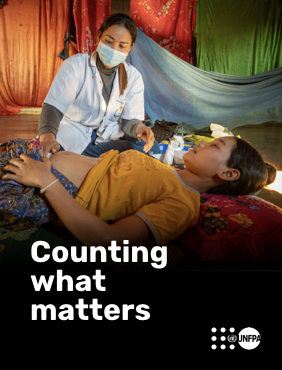
Counting what matters - MPDSR Report
The coronavirus disease 2019 (COVID-19) pandemic has significantly disrupted health services throughout the world, especially for maternal and newborn health. It is estimated that there will be significant increases in maternal and perinatal deaths due to the direct and indirect impacts of the pandemic. Addressing the impacts of the pandemic on sexual, reproductive, maternal, newborn, child and adolescent health has been a key focus of the United Nations Population Fund (UNFPA), with attention given to the protection of health personnel, the improvement of hygiene standards in facilities, and the maintenance of essential health services.

Meeting the moment, to leave no one behind - Digital Report
Meeting the moment, to leave no one behind
The COVID-19 pandemic swept through Asia and the Pacific bringing with it lockdowns, movement restrictions and curfews and disrupting essential sexual and reproductive health and rights and gender-based violence services. In this new landscape, UNFPA had to strengthen advocacy, boost innovation, adapt service modalities and leverage the power of technology to ensure continuity of essential services while at the same time protecting frontline health workers.
DFAT enabled the investment to quickly implement COVID-19 response activities to ensure continued and improved access to sexual and reproductive health and rights and gender-based violence services across the region in six priority countries, Bangladesh, Bhutan, Indonesia, Maldives, Nepal, Papua New Guinea and in the Pacific.
Highlights include:
-
133,072 people utilized integrated sexual and reproductive health services during the project implementation period across the project countries
-
248 service delivery points provided comprehensive gender-based violence service provision and referral mechanisms, including for mental health and psychosocial support across project countries
-
13,953 health care providers were provided with personal protective equipment across project countries
-
54 communications and advocacy materials on sexual and reproductive health and rights and gender-based violence were made available in local languages across project countries
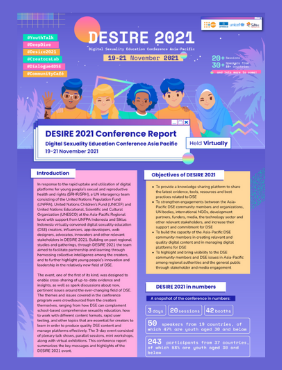
DESIRE 2021: Digital Sexuality Education Conference Asia-Pacific
In response to the rapid uptake and utilization of digital platforms for young people’s sexual and reproductive health and rights (SRHR/SRH), a UN interagency team consisting of the United Nations Population Fund (UNFPA), United Nations Children’s Fund (UNICEF) and United Nations Educational, Scientific and Cultural Organization (UNESCO) at the Asia-Pacific Regional level with support from UNFPA Indonesia and Siklus Indonesia virtually convened digital sexuality education (DSE) creators, influencers, app developers, web designers, advocates, innovators and other relevant stakeholders in DESIRE 2021.
Building on past regional studies and gatherings, through DESIRE 2021 the team aimed to facilitate partnership and learning through harnessing collective intelligence among the creators, and to further highlight young people’s innovation and leadership in the relatively new field of DSE.

Are persons with disabilities included in the effort to leave no-one behind?
In the Asia Pacific region, UNFPA and partners work together to implement the Incheon Strategy to “Make the Right Real” for Persons with Disabilities. The Incheon Strategy is the region’s first set of disability-specific development goals to track progress towards the fulfilment of rights of persons with disabilities.
In the region, it is estimated that there are over 650 million persons with disabilities. However, without accurate, timely and disaggregated data, countries are unable to develop effective policies and programmes, monitor the wellbeing of persons with disabilities and evaluate the equity and impact of development efforts. This endangers country commitments to ‘leave no one behind’ and undermines their obligations to the Convention on the Rights of Persons with Disabilities.
This groundbreaking report demonstrates the importance of ensuring data is inclusive and provides recommendations for immediate action in order to improve the collection, analysis and reporting of disability data. We hope this report will be used as a tool for future advocacy and ultimately better data for all.

Where are we? Questions to aid understanding of disability data and inform advocacy
This is a resource for Organisations of Persons with Disabilities (OPDs) to help determine where your organisation, your country or your partner is positioned in relation to the collection, analysis and reporting of disability data. These questions should help guide you towards what to ask during investigations and the responses should help inform advocacy efforts.

A brief explainer on The Washington Group Questions on Disability
It’s estimated there are 1 billion persons with disabilities in the world.
There is a critical evidence gap regarding the incidence, distribution and experience of persons with disabilities. Although many countries currently collect data on persons with disabilities, the methods used can vary greatly. The result is inconsistent, often poor-quality information which can under-estimate disability prevalence, lacks a nuanced understanding of different types of disabilities, and is not locally, regionally or globally comparable. This may lead decision makers to overlook disability in policies and programming and makes it impossible to benchmark and monitor progress for persons with disabilities.
To address this, The Washington Group on Disability Statistics developed a standard set of universal questions on disability to use in censuses and surveys. These questions identify and measure disability across multiple domains of functioning and enable the comparison of data.
The short set can provide key information for evidence-based advocacy and policies.
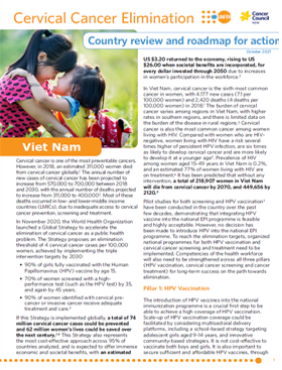
Viet Nam: Cervical Cancer Elimination - Country Review & Roadmap for Action
Cervical cancer is one of the most preventable cancers. However, in 2020, an estimated 341,800 women died from cervical cancer globally. The annual number of new cases of cervical cancer has been projected to increase from 570,000 to 700,000 between 2018 and 2030, with the annual number of deaths projected to increase from 311,000 to 400,0002. Most of these deaths occurred in low- and lower-middle income countries (LMICs) due to inadequate access to cervical cancer prevention, screening and treatment.
In November 2020, the World Health Organization launched a Global Strategy to accelerate the elimination of cervical cancer as a public health problem. If this Strategy is implemented globally, a total of 74 million cervical cancer cases could be prevented and 62 million women’s lives could be saved over the next century.
The UNFPA Asia-Pacific Regional Office together with the Cancer Counsil NSW developed a series of briefs on Cervical Cancer Elimination to guide countries within the region. This is the country review and roadmap for action for Viet Nam.
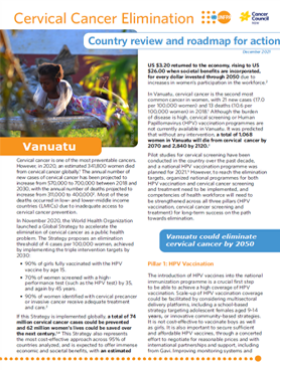
Vanuatu: Cervical Cancer Elimination - Country Review & Roadmap for Action
Cervical cancer is one of the most preventable cancers. However, in 2020, an estimated 341,800 women died from cervical cancer globally. The annual number of new cases of cervical cancer has been projected to increase from 570,000 to 700,000 between 2018 and 2030, with the annual number of deaths projected to increase from 311,000 to 400,0002. Most of these deaths occurred in low- and lower-middle income countries (LMICs) due to inadequate access to cervical cancer prevention, screening and treatment.
In November 2020, the World Health Organization launched a Global Strategy to accelerate the elimination of cervical cancer as a public health problem. If this Strategy is implemented globally, a total of 74 million cervical cancer cases could be prevented and 62 million women’s lives could be saved over the next century.
The UNFPA Asia-Pacific Regional Office together with the Cancer Counsil NSW developed a series of briefs on Cervical Cancer Elimination to guide countries within the region. This is the country review and roadmap for action for Vanuatu.
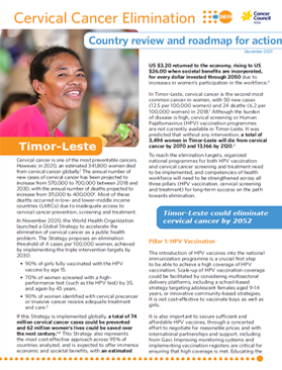
Timor-Leste: Cervical Cancer Elimination - Country Review & Roadmap for Action
Cervical cancer is one of the most preventable cancers. However, in 2020, an estimated 341,800 women died from cervical cancer globally. The annual number of new cases of cervical cancer has been projected to increase from 570,000 to 700,000 between 2018 and 2030, with the annual number of deaths projected to increase from 311,000 to 400,0002. Most of these deaths occurred in low- and lower-middle income countries (LMICs) due to inadequate access to cervical cancer prevention, screening and treatment.
In November 2020, the World Health Organization launched a Global Strategy to accelerate the elimination of cervical cancer as a public health problem. If this Strategy is implemented globally, a total of 74 million cervical cancer cases could be prevented and 62 million women’s lives could be saved over the next century.
The UNFPA Asia-Pacific Regional Office together with the Cancer Counsil NSW developed a series of briefs on Cervical Cancer Elimination to guide countries within the region. This is the country review and roadmap for action for Timor-Leste.